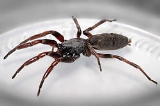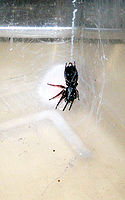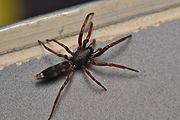
White-tailed spider
Encyclopedia

Spider
Spiders are air-breathing arthropods that have eight legs, and chelicerae with fangs that inject venom. They are the largest order of arachnids and rank seventh in total species diversity among all other groups of organisms...
s native to southern and eastern Australia
Australia
Australia , officially the Commonwealth of Australia, is a country in the Southern Hemisphere comprising the mainland of the Australian continent, the island of Tasmania, and numerous smaller islands in the Indian and Pacific Oceans. It is the world's sixth-largest country by total area...
, and so named because of the whitish tips at the end of their abdomen
Abdomen
In vertebrates such as mammals the abdomen constitutes the part of the body between the thorax and pelvis. The region enclosed by the abdomen is termed the abdominal cavity...
s. Common species are Lampona cylindrata and Lampona murina. Both these species have been introduced
Introduced species
An introduced species — or neozoon, alien, exotic, non-indigenous, or non-native species, or simply an introduction, is a species living outside its indigenous or native distributional range, and has arrived in an ecosystem or plant community by human activity, either deliberate or accidental...
to New Zealand
New Zealand
New Zealand is an island country in the south-western Pacific Ocean comprising two main landmasses and numerous smaller islands. The country is situated some east of Australia across the Tasman Sea, and roughly south of the Pacific island nations of New Caledonia, Fiji, and Tonga...
.
White-tailed spiders are vagrant hunters who seek out prey rather than spinning a web to capture it. Their preferred prey is other spiders and they are equipped with venom for hunting.
They are known to bite humans and effects may include local pain
Pain
Pain is an unpleasant sensation often caused by intense or damaging stimuli such as stubbing a toe, burning a finger, putting iodine on a cut, and bumping the "funny bone."...
, a red mark, local swelling and itchiness; very occasionally nausea
Nausea
Nausea , is a sensation of unease and discomfort in the upper stomach with an involuntary urge to vomit. It often, but not always, precedes vomiting...
, vomiting
Vomiting
Vomiting is the forceful expulsion of the contents of one's stomach through the mouth and sometimes the nose...
, malaise
Malaise
Malaise is a feeling of general discomfort or uneasiness, of being "out of sorts", often the first indication of an infection or other disease. Malaise is often defined in medicinal research as a "general feeling of being unwell"...
or headache
Headache
A headache or cephalalgia is pain anywhere in the region of the head or neck. It can be a symptom of a number of different conditions of the head and neck. The brain tissue itself is not sensitive to pain because it lacks pain receptors. Rather, the pain is caused by disturbance of the...
may occur. Ulcers and necrosis
Necrosis
Necrosis is the premature death of cells in living tissue. Necrosis is caused by factors external to the cell or tissue, such as infection, toxins, or trauma. This is in contrast to apoptosis, which is a naturally occurring cause of cellular death...
have been attributed to the bites, but a scientific study by Isbister and Gray (2003) showed these were probably caused by something else, as the study of 130 white-tailed spider bites found no necrotic ulcers or confirmed infections.
Taxonomy
Ludwig Carl Christian KochLudwig Carl Christian Koch
Ludwig Carl Christian Koch was a German entomologist and arachnologist.He was born in Regensburg, Germany and died in Nuremberg, Germany. He studied in Nuremberg, initially law, but then turned to medicine and science...
described Lampona cylindrata in 1866 and Lampona murina in 1873. The genus name comes from the Latin lampo which means shine. The species name cylindrata refers to the cylindric body shape, while murinus means "mouse-gray" in Latin.
Description

The similarities have led people to think there is only one species of white-tailed spider. It is possible that not all white-tailed species have been identified. The descriptor, white tail, is applied to a variety of species of spiders for which a distal white mark on their abdomen is a distinctive feature; other markings disappear with moultings but the white tail remains to adulthood.
L. cylindrata lay pinkish eggs which are enclosed in a flattened silk capsule and are guarded by the female until they hatch.
Distribution
Both species are native to Australia. Lampona cylindrata is present across south-east Queensland, New South Wales, Victoria, South Australia, Tasmania and Western Australia while Lampona murina is found in eastern Australia from north-east Queensland to Victoria. The spiders have been introduced in New Zealand with Lampona murina residing in the North Island for over a hundred years while Lampona cylindrata has become widespread throughout the South Island since 1980.Habitat and behaviour
They live in gardens and inside houses, beneath bark and rocks, in leaf litter and are often found in the folds of clothes, towels and shoes. They do not build webs. They are able to walk on glass, due to specialized hairs on the end of their legs. Most active at night, they hunt for other spiders. Their favoured prey is the black house spiderBlack house spider
The black house spider is a common species of cribellate Australian spider, found throughout much of Australia and New Zealand. A closely related species, the grey house spider , has a similar distribution....
.
Bites to humans
White-tailed spiders wander about human dwellings (beds) and may be encountered unexpectedly, unlike the black house spiderBlack house spider
The black house spider is a common species of cribellate Australian spider, found throughout much of Australia and New Zealand. A closely related species, the grey house spider , has a similar distribution....
and the redback which are more often seen in a web. They may be responsible for a disproportionately high number of spider bites compared with other Australian spiders, because of their wandering habits. Of the 130 cases studied by Isbister and Gray, more than 60% of the victims had been bitten by spiders that had got into clothing, towels or beds.
The bite of white-tailed spiders has been wrongly implicated in cases of arachnogenic necrosis. The misassociation stems from a paper presented at the International Society on Toxinology
Toxinology
Toxinology is the specialized area of science that deals specifically with animal, plant, and microbial toxins. Prof. Dietrich Mebs has defined toxinology as "the scientific discipline dealing with microbial, plant and animal venoms, poisons and toxins". Additionally stating that "toxinology...
World Congress held in Brisbane in 1982. Both white-tailed and the wolf spider
Wolf spider
Wolf spiders are members of the family Lycosidae, from the Ancient Greek word "" meaning "wolf". They are robust and agile hunters with good eyesight. They live mostly solitary lives and hunt alone. Some are opportunistic hunters pouncing upon prey as they find it or even chasing it over short...
were considered as candidates for possibly causing suspected spider bite necrosis
Necrosis
Necrosis is the premature death of cells in living tissue. Necrosis is caused by factors external to the cell or tissue, such as infection, toxins, or trauma. This is in contrast to apoptosis, which is a naturally occurring cause of cellular death...
, though it later turned that the recluse spider
Recluse spider
The recluse spiders or brown spiders , also known as fiddle-back, violin spiders or reapers, are a venomous genus of spiders known for their necrotic bite, which sometimes produces a characteristic set of symptoms known as Loxoscelism...
was the culprit in the reported cases from Brazil
Brazil
Brazil , officially the Federative Republic of Brazil , is the largest country in South America. It is the world's fifth largest country, both by geographical area and by population with over 192 million people...
.
Following this initial report, numerous other cases implicated white-tailed spiders in causing necrotic ulcers. All of these cases lacked a positively identified spider—or even a spider bite in some cases. Additionally there had not been a case of arachnogenic necrosis reported in the two hundred years of European colonisation
Colonisation
Colonization occurs whenever any one or more species populate an area. The term, which is derived from the Latin colere, "to inhabit, cultivate, frequent, practice, tend, guard, respect", originally related to humans. However, 19th century biogeographers dominated the term to describe the...
before these cases. Clinical toxicologist Geoffrey Isbister studied 130 cases of arachnologist-identified white-tailed spider bites, and found no necrosis or confirmed infections, concluding that such outcomes are very unlikely for a white-tailed spider bite. The major effects from a bite were local pain
Pain
Pain is an unpleasant sensation often caused by intense or damaging stimuli such as stubbing a toe, burning a finger, putting iodine on a cut, and bumping the "funny bone."...
, a red mark, local swelling and itchiness; rarely systemic effects of nausea
Nausea
Nausea , is a sensation of unease and discomfort in the upper stomach with an involuntary urge to vomit. It often, but not always, precedes vomiting...
, vomiting
Vomiting
Vomiting is the forceful expulsion of the contents of one's stomach through the mouth and sometimes the nose...
, malaise
Malaise
Malaise is a feeling of general discomfort or uneasiness, of being "out of sorts", often the first indication of an infection or other disease. Malaise is often defined in medicinal research as a "general feeling of being unwell"...
or headache
Headache
A headache or cephalalgia is pain anywhere in the region of the head or neck. It can be a symptom of a number of different conditions of the head and neck. The brain tissue itself is not sensitive to pain because it lacks pain receptors. Rather, the pain is caused by disturbance of the...
occurred. All these symptoms are generally mild and resolve over time.
External links
- White-tailed spiders at the Australian MuseumAustralian MuseumThe Australian Museum is the oldest museum in Australia, with an international reputation in the fields of natural history and anthropology. It features collections of vertebrate and invertebrate zoology, as well as mineralogy, palaeontology, and anthropology...
- White-tailed spiders at Landcare Research, New Zealand

